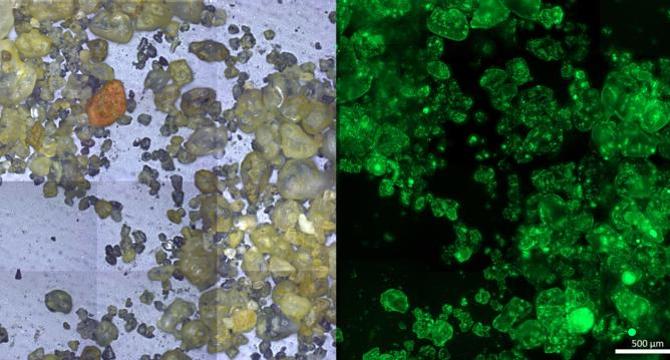Bioengineer
5d
212

Image Credit: Bioengineer
Tiny Anoxic Pockets Trigger Major Nitrogen Loss on Sandy Shores
- Recent research by scientists at the Max Planck Institute for Marine Microbiology reveals the role of microbial colonies on sand grains in nitrogen removal from coastal sediments, creating anoxic microhabitats for anaerobic processes.
- Advanced microfluidic imaging techniques allowed the team to discover clusters of microbes depleting oxygen in minuscule anoxic niches on individual sand grain surfaces.
- These anoxic microenvironments enable anaerobic denitrification to occur in oxygenated coastal sands, contributing significantly to nitrogen loss in permeable coastal sediments.
- The study showcases the importance of microbial spatial distribution and metabolic activity in shaping sedimentary nitrogen fluxes, offering insights for global nitrogen budgeting and ecosystem responses to human impacts.
- Microbial communities on sand grains serve as a crucial sink for anthropogenic nitrogen, mitigating eutrophication and hypoxic zones in coastal waters.
- Technological advancements in microfluidic imaging bridge microscale processes with macroscale ecological effects, underscoring the complexity and resilience of sediment microbiomes.
- The research emphasizes the environmental significance of microhabitat heterogeneity in biogeochemical modeling and identifies the powerful role of microorganisms in regulating planetary health.
- Understanding how microbial consortia adapt to environmental changes within these anoxic microenvironments can enhance predictive models of nitrogen cycling under shifting climate conditions.
- This study challenges traditional paradigms and accentuates the impact of minuscule biological structures on large-scale environmental processes, advocating for sustainable environmental stewardship.
- Through uncovering the mechanisms of microbial habitat engineering on sand grain surfaces, this research enriches our comprehension of coastal nitrogen dynamics and offers valuable insights for ecological conservation.
- The findings highlight the intricate interplay of microbial activity, oxygen gradients, and microhabitat resilience, showcasing the importance of understanding microscale processes in global biogeochemical cycles.
Read Full Article
12 Likes
For uninterrupted reading, download the app